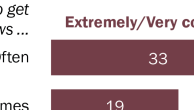Cross-Ownership
Another ownership category likely to be affected by the FCC ruling is cross-ownership within a market-that is, one company owning both a newspaper and a television station in the same metropolitan area. To understand what these changes might mean, we looked at instances where such cross-ownership situations already exist and compared them to the rest of the stations in this study. Six stations fell into this category: WSB in Atlanta, WBRZ in Baton Rouge, WFAA in Dallas, WZZM in Grand Rapids, WFLA in Tampa and KRON in San Francisco.1
While this number is small, the six stations represent almost a quarter of the 26 stations across the country where a cross-ownership exists.2
In our data, cross-ownership led to better grades. Stations in cross-ownership situations were more than twice as likely to receive an “A” grade than were other stations. (Incidentally, none of the six earned an “F” grade in quality, compared with 7% of all other stations, though the small size of this ownership category is too small to infer much from that).
Interestingly, these higher grades for stations in cross ownership did not translate to better ratings trends. These stations were twice as likely to have high grades but declining ratings trends. They were also more likely to have low grades and declining ratings trends.
|
Ratings Performance: Cross-Owned and Non-Cross-Owned
|
||
| Ratings Trend |
Cross-Owned Stations
|
Non-Cross-Owned Stations
|
| Improving |
17%
|
43%
|
| Flat |
17
|
19
|
| Declining |
66
|
38
|
| Total |
100%
|
100%
|
Why? One possible explanation is that the category size is small. Another possible explanation that could be considered with further study of more cross owned stations is that it has something to do with being owned by companies more heavily focused around newspapers than television. It is possible, perhaps, that newspaper-oriented companies have weaker grasp of the norms of broadcasting than do television stations. Or, perhaps, cross-ownership itself may not encourage ratings success. Trying to import print norms and telling print stories on TV may turn away audiences rather than attract them.
Newscasts on cross-owned stations were noticeably different than others, at least according to the empirical breakdown.
On the whole, they were more likely to do stories that focused on important community issues, more likely to provide a wide mix of opinions, and less likely to do celebrity and human-interest features. Cross-owned stations were also, however, slightly less enterprising than other stations-perhaps in contrast to the expectation that the combined resources of a newspaper and TV station in collaboration would lead to more.
Here are some specifics:
- On Significance: Cross-owned stations aired more stories that looked at important trends and ideas in their communities (19% vs. 14% for all other stations). They were less likely than other stations to air celebrity news or human-interest features (10% vs. 14%).
- On Balance and Accuracy: Cross-owned stations aired more than one side of the matter in roughly half of all controversial stories (46%) compared with only 39% in all other stations.
- On Enterprise: Here cross-owned stations didn’t fare as well. Their scores for enterprise overall were lower. In particular, a third of all the stories on these stations involved sending a camera without a correspondent (32%), compared with almost one-quarter (23%) at all other stations. On the other hand, these stations relied less on syndicated wire feed material (15% vs. 20% for other stations).
It should be noted that many cross-ownership situations date back to before the FCC rules against cross-ownership were instituted in 1975 and were allowed to continue thanks to a “grandfather” clause. In many cases, these stations are operating in an environment where collaboration between co-owned TV and newspaper outlets has been “taboo” for two decades and broadcasters may have been more sensitive to the appearance of relying to heavily on their print counterparts. This concern is only now starting to wane, due in part to the symbolic impact of lessening FCC oversight and the growing strategic emphasis inside news companies on “convergence.”
The data on enterprise deserves some further reflection. On its face, cross-ownership might have suggested that the joint resources of a newspaper and TV station would have freed up people to do more original work. But the fact that the cross-owned stations actually scored lower on our enterprise index in general, and particularly in the area of sending out reporters to cover stories, suggests something else may be at play. It is possible that cross-owned stations actually have fewer reporters than others to send out. Or, perhaps, newspaper companies, more so than other companies, are using their TV stations as cash infusers to the rest of the company. It is possible that the six stations we happened to have studied were unusual. But the generalized sign of higher quality at cross-owned stations, for some reason, did not include those stations doing more enterprise.
1 At the time we studied KRON in winter 1999 it was owned by the Chronicle Company, which also owned the San Francisco Chronicle; the Chronicle Company was eventually broken up and the two outlets are now owned by different corporations.
2 See David Pritchard, “Viewpoint Diversity in Cross-Owned Newspapers and Television Stations: A Study of News Coverage of the 2000 Presidential Campaign,” available through the FCC’s website.




